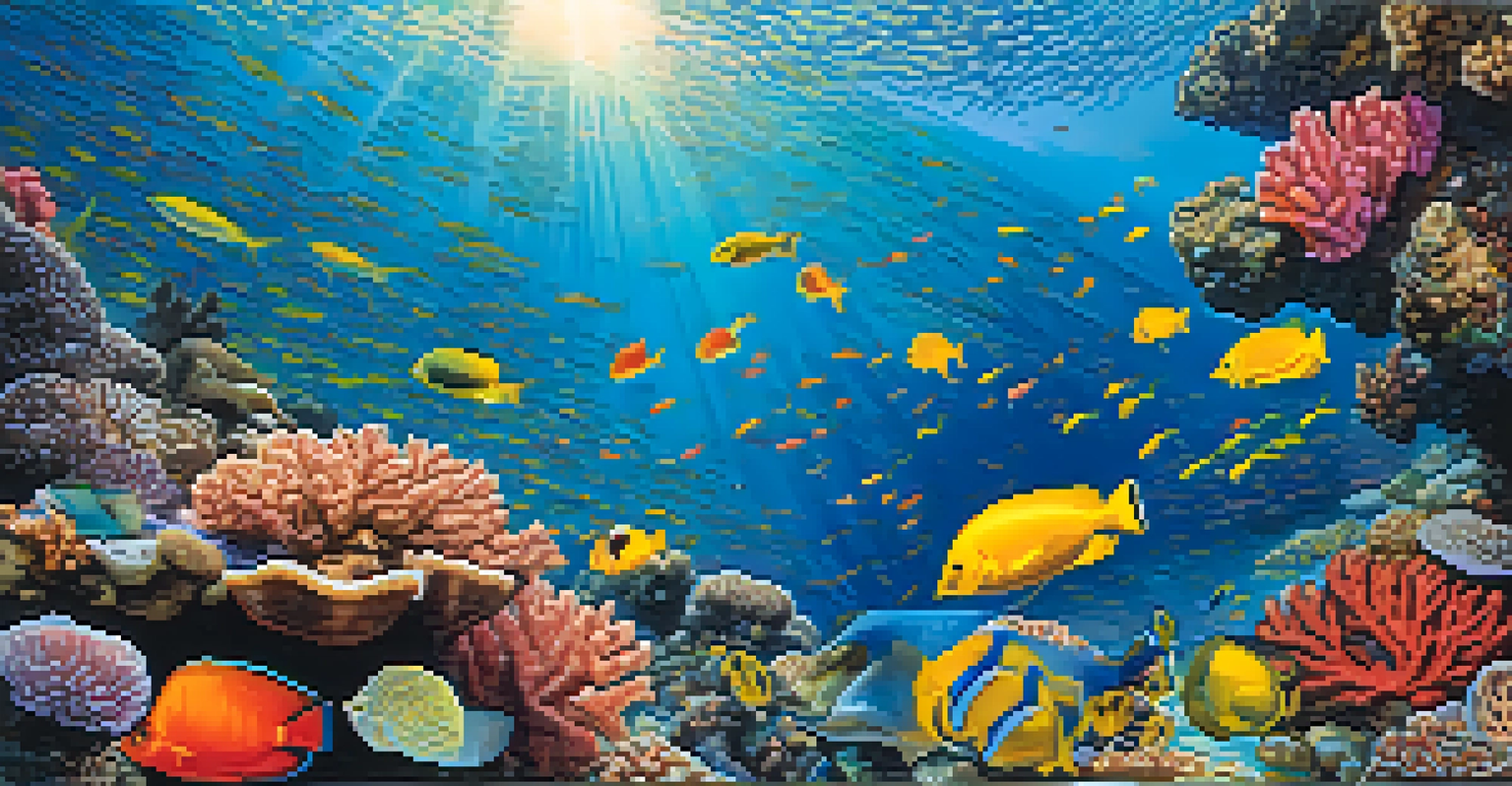The Influence of Tourism on Hawaii's Environmental Health

Understanding Hawaii's Unique Environmental Landscape
Hawaii is renowned for its stunning landscapes, from lush rainforests to pristine beaches. These unique ecosystems are not just beautiful; they are essential for biodiversity and local culture. The islands are home to many endemic species, meaning they can only be found there. This rich environmental tapestry is what draws millions of tourists each year, but it also poses significant challenges.
The greatest threat to our planet is the belief that someone else will save it.
The delicate balance of Hawaii's ecosystems is easily disrupted by human activity, and tourism is a major contributor. When visitors flock to popular sites, they can unintentionally harm native plants and wildlife. This is particularly concerning in areas like coral reefs, which can be damaged by increased foot traffic and pollution. Understanding this impact is crucial for fostering sustainable tourism practices.
As we delve deeper into tourism’s influence, we must recognize the responsibility that comes with visiting such a unique place. The beauty of Hawaii is a treasure, but it requires careful stewardship to ensure it remains intact for future generations. This understanding sets the stage for a more profound discussion about tourism’s overall effects on Hawaii's environmental health.
The Pressure of High Tourist Footfall on Resources
Hawaii welcomes around 10 million visitors annually, a staggering number for such a small group of islands. This influx can place immense pressure on natural resources, such as water and energy. For instance, the demand for fresh water skyrockets, especially during peak tourist seasons, which can lead to shortages for local residents and agriculture.

Moreover, the waste generated by tourists adds another layer of strain on Hawaii's waste management systems. Landfills can quickly become overwhelmed, leading to pollution and environmental degradation. Local governments are often left scrambling to manage this waste effectively, raising concerns about the long-term sustainability of their practices.
Tourism Strains Hawaii's Resources
The influx of around 10 million annual visitors places immense pressure on Hawaii's natural resources, including water and waste management systems.
Addressing these resource challenges requires collaboration between local authorities, businesses, and tourists themselves. Implementing sustainable practices, such as promoting eco-friendly accommodations and encouraging water conservation, can help alleviate some of the pressure on Hawaii's precious resources.
Coral Reefs: The Canaries of Hawaii's Marine Health
Hawaii's coral reefs are often described as the 'canaries in the coal mine' for marine health. These vibrant ecosystems are vital for marine life, acting as nurseries for fish and protecting coastlines from erosion. However, they are incredibly sensitive to changes in water temperature, pollution, and physical damage from tourism activities.
In every walk with nature one receives far more than he seeks.
Rising sea temperatures, partly attributed to climate change, have led to coral bleaching events, which can devastate these ecosystems. When tourists engage in activities like snorkeling or diving without proper care, they risk further damaging these fragile reefs. This highlights the need for better education about responsible behavior while enjoying Hawaii's natural wonders.
Protecting coral reefs is not just about preserving beauty; it’s essential for maintaining the ecological balance of marine environments. Initiatives like the establishment of marine protected areas can help safeguard these critical habitats, ensuring that they continue to thrive despite the pressures of tourism.
Wildlife Conservation Amidst Touristic Growth
Hawaii is home to some of the world’s rarest wildlife, including the Hawaiian monk seal and the endangered bird species like the ‘I’iwi. However, the growth of tourism poses significant threats to these animals and their habitats. Increased human activity can lead to habitat destruction, disturbance during breeding seasons, and even direct harm from interactions with tourists.
Conservation efforts are crucial to protect these unique species, and many organizations are working tirelessly to raise awareness. Programs that educate tourists about local wildlife and the importance of conservation can foster a sense of responsibility among visitors. For example, wildlife tours that emphasize ethical viewing practices allow tourists to appreciate these creatures without causing harm.
Coral Reefs Indicate Marine Health
Hawaii's coral reefs are crucial for marine ecosystems, yet they are highly vulnerable to climate change and tourism-related damage.
Ultimately, striking a balance between tourism and wildlife conservation is essential. By promoting responsible tourism and supporting local conservation initiatives, visitors can help ensure that Hawaii’s unique wildlife continues to thrive.
Cultural Heritage and Environmental Sustainability
Hawaii's rich cultural heritage is deeply intertwined with its natural environment. Traditional practices, such as fishing and farming, have been passed down through generations and are closely connected to the land and sea. However, the influx of tourists can sometimes overshadow these cultural traditions, leading to a disconnect between visitors and the local way of life.
Promoting cultural tourism that highlights and respects native practices can benefit both the environment and the community. For instance, eco-tours led by local guides can educate visitors about sustainable practices that have been used for centuries. This not only enhances the tourist experience but also empowers local communities to share their knowledge and traditions.
The preservation of cultural heritage is vital for maintaining a sense of identity and pride among local residents. By fostering an appreciation for Hawaii's unique culture, tourists can contribute to the sustainability of both the environment and the community.
Mitigating Environmental Damage Through Sustainable Practices
Sustainable tourism practices are essential for mitigating the environmental impact of tourism in Hawaii. This includes initiatives like promoting eco-friendly accommodations, encouraging the use of public transportation, and supporting local businesses. When tourists make conscious choices, they can help reduce their carbon footprint and lessen their impact on the islands.
Many organizations are working to implement sustainable practices, such as waste reduction programs and conservation efforts in popular areas. These initiatives not only benefit the environment but also enhance the overall experience for visitors. Tourists who engage with sustainable practices often find a deeper connection to the land and its people.
Conserving Wildlife Amid Tourism Growth
The growth of tourism threatens Hawaii's unique wildlife, necessitating effective conservation efforts and responsible tourist behavior.
Ultimately, sustainable tourism is about creating a win-win situation where both the environment and the local community can thrive. By adopting responsible behaviors and supporting sustainable initiatives, tourists can play a pivotal role in preserving Hawaii's natural beauty.
The Role of Education in Promoting Environmental Health
Education plays a crucial role in promoting environmental health in Hawaii amidst rising tourism. Awareness campaigns can inform both locals and visitors about the importance of protecting the islands' delicate ecosystems. Simple actions, like staying on designated paths or minimizing waste, can significantly impact the preservation of Hawaii's environment.
Schools and local organizations are increasingly incorporating environmental education into their programs. By teaching children about sustainability from a young age, Hawaii can cultivate a generation that values and protects its natural resources. This focus on education can also extend to tourists, offering workshops or informational sessions to enhance their understanding of local ecosystems.

When people are educated about the impact of their actions, they are more likely to make responsible choices. Empowering both residents and visitors with knowledge is a vital step toward ensuring the long-term health of Hawaii's environment.